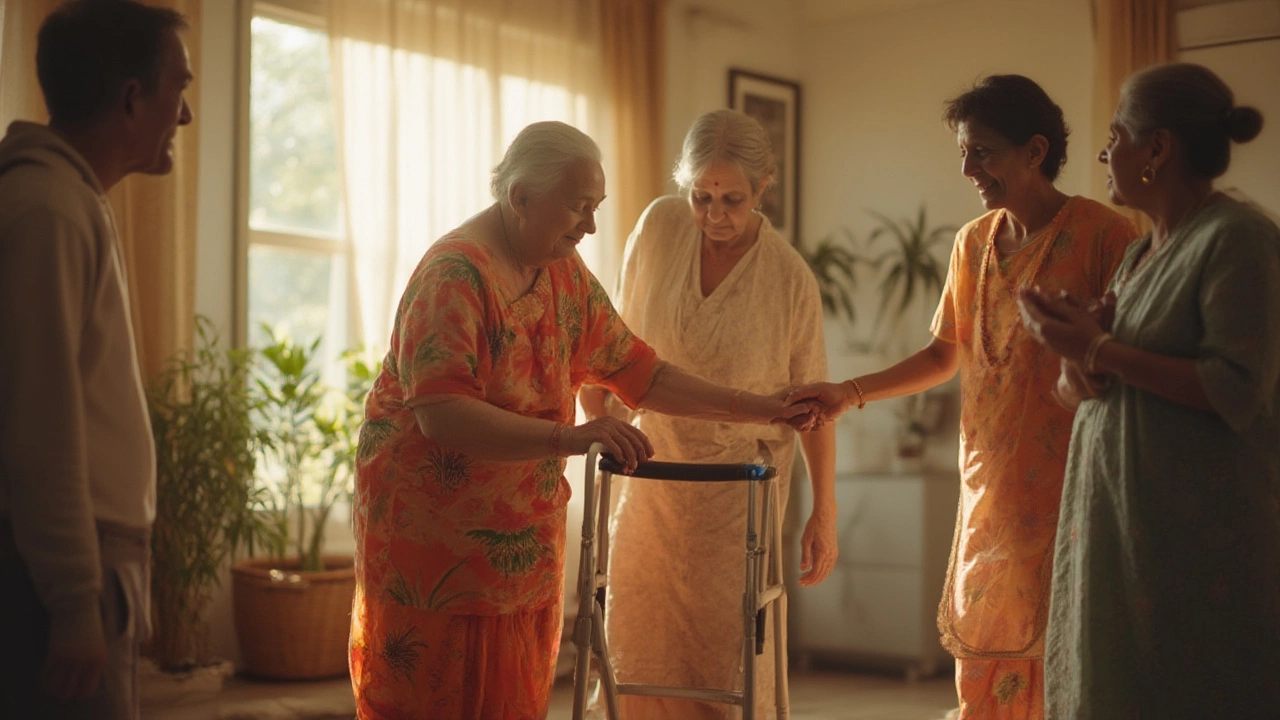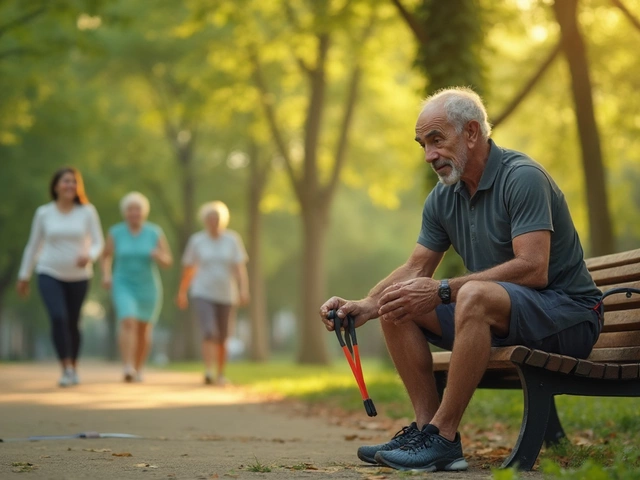Spend a minute in the waiting area of any orthopedic clinic, and you’ll hear: "How soon can I walk again, doc?" The truth is, fast recovery after knee replacement isn’t reserved for super-fit athletes or Instagram influencers. But not everyone talks about how much you can do to take charge of your own healing—and yes, speed things up. Surgeons now expect most people to stand on their new knee the same day, sometimes within hours. That’s a wild leap from your grandfather’s surgery days, when a hospital bed became a second home for weeks. Still, not everyone heals at the same rate, and what you do day by day can make or break your recovery speed.
The Science Behind Fast Knee Replacement Recovery
Doctors call it Enhanced Recovery After Surgery (ERAS). What’s that? It’s a set of best practices, honed by thousands of knee surgeries every year, to shave days—and even weeks—off recovery. Instead of the old "bed rest is best" thinking, new science points to early movement, smart pain control, and some surprising lifestyle tricks that boost your odds of bouncing back faster. Let’s break down what actually works.
First up: movement matters more than you think. Studies published in journals like The Lancet show that standing or even walking a few steps just hours after surgery cuts hospital stays by half. One 2022 review of 14,000 knee surgeries found that patients mobilized on day one were 45% less likely to stay longer than needed compared to those who waited even a day or two. Hospitals have responded in kind: now, almost 90% of U.S. joint replacement centers have "fast-track" programs, getting people up with a walker sometimes within three hours of surgery.
But it’s not just about how soon you get out of bed; it’s what you do before and after surgery. Physical therapy isn’t optional—think of it like taking prescription medicine. If you want your new knee to feel "yours" again, rehab exercises will get you there. A study from Mayo Clinic tracked recovery times in people who stuck to their prescribed programs versus those who skipped PT sessions. The first group climbed stairs without pain up to two weeks sooner.
Let’s bust another myth: painkillers are not your only friend. Too much reliance on strong opioids like oxycodone can backfire—causing constipation, sleep issues, and slower mobility. Hospitals have shifted to what’s called multimodal pain relief. That means a mix of meds, ice packs, careful movement, and sometimes nerve blocks that numb only the knee. You stay more awake, your stomach stays happy, and you walk sooner. The numbers? A Harvard study found people on this pain plan took 40% fewer narcotics and recovered function 30% faster, all without more pain.
Want some cold, hard data? Here’s a quick view:
| Recovery Milestone | Average Time (Enhanced Recovery) | Average Time (Traditional) |
|---|---|---|
| Standing with help | 6-12 hours | 24-36 hours |
| Walking 100 feet | 1-2 days | 3-5 days |
| Stairs without cane | 4-6 weeks | 8-10 weeks |
| Back to driving | 4-6 weeks | 8-12 weeks |
Don’t let those numbers box you in—they’re averages. But they show how modern care, and being proactive, genuinely speeds healing.

Daily Habits That Supercharge Your Recovery
The hospital is only where the journey starts. Real progress happens at home, and here’s where little choices have big effects. Every day, keep your eyes on these priorities to keep momentum going—and steer clear of setbacks that could keep you sidelined.
- Stick to your exercise script. Even if you’re tired or sore, gentle movement, like straightening the knee or wiggling your ankles, stops scar tissue from gumming up your new joint. Missing a day or two sets you back more than you’d think.
- Ice, elevate, repeat. Swelling isn’t just uncomfortable; it slows healing. Keep ice packs handy, and prop your leg above heart level multiple times daily. One study found people who iced three times a day recovered flexion nearly a week faster than those who skipped it.
- Don’t go solo. If you live alone, ask friends or family to check in, or arrange for a home health aide just for the first few weeks. People who had daily support healed quicker—sometimes simply because someone kept them on track with exercises and reminded them to drink water.
- Eat like you mean it. Your body needs building blocks to put itself back together: lean protein, vitamin-rich veggies, and plenty of water. Processed snacks make inflammation worse, while more balanced meals (think eggs, yogurt, fish, berries) have been shown to cut time to full mobility by several days on average.
- Sleep is non-negotiable. Poor sleep can fuel pain and suck motivation out of your rehab effort. Prioritize a dark, cool room and limit caffeine in the hours before bedtime. Wearing out your body in therapy, then skipping on sleep, only drags out recovery. A study in The Journal of Orthopaedics linked good sleep (7-8 hours) with a 30% reduction in reported post-surgical pain by week 3.
- Watch your step—literally. Trips and falls are the number one cause of emergency room visits after knee surgery. Clear clutter from your floor, use night lights, and wear shoes with grippy soles. Nearly 12% of setbacks after knee replacement are due to simple falls at home.
- Celebrate small wins. It might sound cheesy, but each new achievement (going up stairs, bending your knee more than yesterday) actually wires your brain to keep progressing. Some physical therapists even recommend keeping a "recovery journal"—simple, but people who track improvement often feel less anxious, and bounce back quicker.
Most important? Be patient but proactive. Frustration is normal. But the body's healing machinery works best when you do a little, often, instead of trying to leap ahead and risking an injury or losing ground to pain.

When to Push, When to Rest: The Trickiest Part Of Speedy Recovery
Now for the mental battle. You want to heal fast—everyone does. But too much, too soon can backfire every bit as much as taking a complete backseat. So, how do you know when you’re pushing in a healthy way, versus pushing into trouble?
Physical therapists (the real experts in day-to-day knee recovery) say: "Listen to the ache, ignore the fear." There’s a difference between discomfort, which is a sign you’re rebuilding muscle, and sharp pain, which suggests something’s irritated or off. Smart recovery means gently finding your limits, not ignoring all signs your body puts up. If pain sticks around for more than an hour after exercise, or if your knee gets hot, puffy, or red, take it easy and ice right away. Otherwise, keep moving—even if it’s just a few steps more than yesterday.
Mistakes happen. People get impatient in week three or four, hear about a friend who went back to pickleball after a month, and jump into old routines. 30% of patients admit to "cheating" on doctors’ instructions, but the stats aren’t kind. The British Orthopedic Association found that people who tried to resume sports or heavy chores early were twice as likely to end up with stiffness or knee "locking," requiring more treatment.
Recovery isn’t only physical. A lot of people feel blue after surgery, or worry they’ll never walk right again. Don’t let that spiral. Stress is proven to slow wound healing. Reach out to your care team if you’re struggling—they’ve heard it all before. If you want to add meditation or deep breathing to ease nerves, go for it. Even five minutes a day can drop blood pressure and help pain meds work better.
If setbacks do happen—maybe your knee feels stuck, or you develop a fever—don’t wait, hoping it will go away. Infection or a blood clot can be sneaky, but fast action keeps small problems from turning into long recoveries.
So what’s the real fastest way to recover from a knee replacement? It’s being all in on the basics: get moving early, do your exercises, mind your diet, ice and elevate, sleep well, ask for help, and keep your eyes on the small wins. Doctors and therapists can open the door, but you’re the one walking through—sometimes literally hours after your operation. Your new knee is designed to last decades. The right start gets you there, and keeps you moving at your own best speed.

 Can You Avoid Knee Replacement if You Are Bone-on-Bone?
Can You Avoid Knee Replacement if You Are Bone-on-Bone?
 How Long Are You Bedridden After Open-Heart Surgery?
How Long Are You Bedridden After Open-Heart Surgery?
 Why Therapists Watch Your Hands: Understanding Non‑Verbal Cues
Why Therapists Watch Your Hands: Understanding Non‑Verbal Cues
 How to Stop Cancer Cells from Growing: Key Treatments Explained
How to Stop Cancer Cells from Growing: Key Treatments Explained
 Understanding How Quickly Herbal Supplements Take Effect in Your Body
Understanding How Quickly Herbal Supplements Take Effect in Your Body